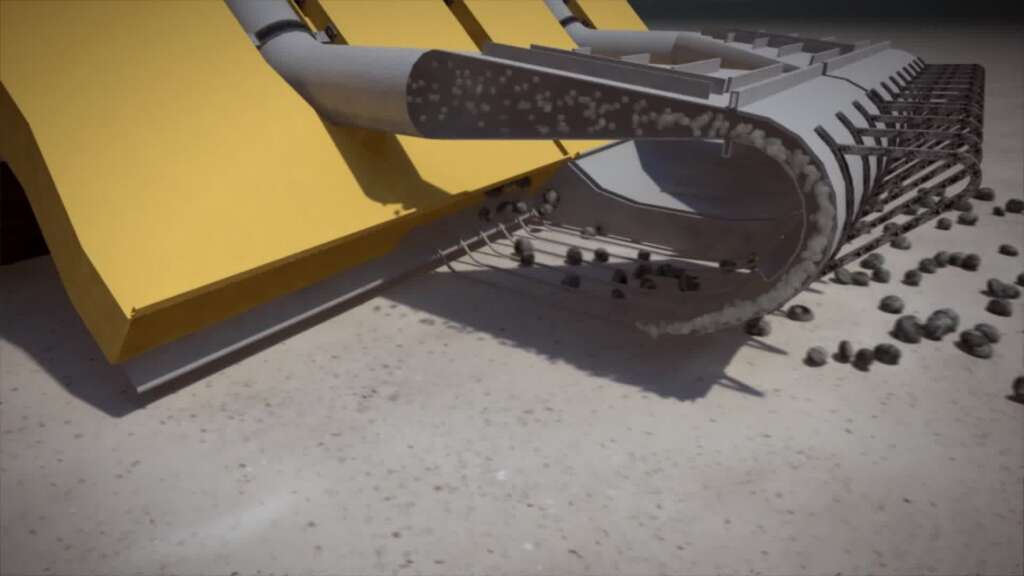
INTERNATIONAL PATENT PROTECTION FOR GSR’S POLYMETALLIC NODULE COLLECTOR HEAD
October 10, 2021
Press Release
Global Sea Mineral Resources (GSR), the deep sea exploration division of DEME Group, has applied for an international patent protection for its polymetallic nodule collector head.
The collector head is a critical component of the seafloor nodule collection system that was successfully tested by GSR in the Pacific Ocean at a water of depth of 4,500 metres in April and May this year.
As the seafloor nodule collector moves across the seafloor, it uses jet water pumps to lift nodules into a collection drum. The collector head is a precision engineered device that has been designed to collect nodules from the seabed while minimising disturbance of the surrounding sediment.
This precautionary approach helps to ensure that GSR’s environmental assessments are as comprehensive and as robust as they can possibly be as the company moves closer to the development of a full-scale system, including riser pipe to bring the nodules to the surface.
As part of the recent deep-water trials, scientists on board GSR’s vessel were able to forecast and track the sediment plume created by the nodule collection process. Initial results suggest that most of the sediment is deposited in the vicinity of the collection area.
GSR is working closely with multiple research institutions focused on establishing environmental baseline measurements and impact assessments to better understand the effect of nodule collection on the marine environment and to ensure decisions are based on the best science possible. Delivering a source of low carbon minerals The successful deep-water trial conducted earlier this year – which involved a full-scale collector head – could help pave the way for delivering a much-needed source of low carbon minerals. Polymetallic nodules are rich in metals critical for clean energy technologies, including nickel, cobalt, copper and manganese. Demand for these metals is set to expand dramatically, driven by the urgent need to build a decarbonised energy system and a growing and rapidly urbanising global population. The most recent analysis from the International Energy Agency (IEA)[1] suggests that to reach the goals of the Paris Agreement, cobalt supply will need to grow 21-fold and nickel 19-fold by 2040. “The climate and biodiversity crises are coinciding with a massive increase in global population,” said Kris Van Nijen, Managing Director of GSR. “Decarbonising a rapidly urbanising planet will require huge amounts of primary metals for clean energy technologies. We’re transitioning from a planet that runs on fossil fuels to a planet that runs on minerals. But there’s a paradox that needs to be recognised. Sourcing these metals – from any location - will have an impact on the planet we are trying to protect. Society needs to confront this challenge, recognise different solutions have different implications and we need to choose the options that do least harm. Our focus is on developing a source of high grade, low carbon minerals which can work alongside other strategies to reach the eventual goal of a circular economy and a stable planet.” Polymetallic nodules Polymetallic nodules, as their name suggests, are multi-metal and it is estimated that the nodules found in the CCZ contain 1.2 times more manganese, 1.8 times more nickel and 3.4 times more cobalt than all known land-based reserves combined[2]. Furthermore, these nodules also contain significant amounts of copper. Nickel, copper, manganese and cobalt never appear all together in terrestrial deposits; two to three separate land-based mines are needed to extract them, often resulting in deforestation, waste due to overburden removal as well as tailings, the displacement of communities and the creation of transport networks in increasingly remote areas. The multi-metal nature of seabed nodules means there are, in effect, two or three land-based mines in one, drastically reducing waste and CO2 emissions per tonne of metal mined. As demand for minerals escalates it will be increasingly important to maintain a diversity of supply. Alongside the responsible mining houses and operators, GSR believes seabed minerals could provide a responsible source of much-needed metals. GSR is currently preparing for its next technology trial in late 2024 when nodules will be collected using a full-scale seafloor nodule collector and transported to the surface via an enclosed riser pipe. [1] The Role of Critical Minerals in Clean Energy Transitions, May 2021 [2] Deep-ocean polymetallic nodules as a resource for critical materials, Hein et al, 2020

